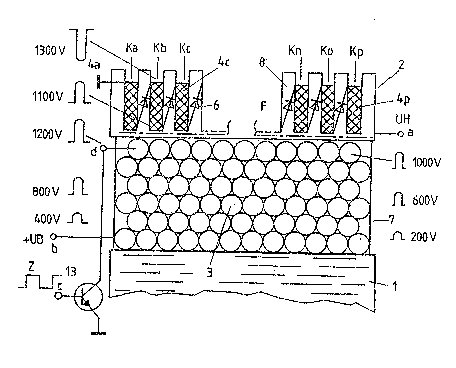Une partie des informations de ce site Web a été fournie par des sources externes. Le gouvernement du Canada n'assume aucune responsabilité concernant la précision, l'actualité ou la fiabilité des informations fournies par les sources externes. Les utilisateurs qui désirent employer cette information devraient consulter directement la source des informations. Le contenu fourni par les sources externes n'est pas assujetti aux exigences sur les langues officielles, la protection des renseignements personnels et l'accessibilité.
L'apparition de différences dans le texte et l'image des Revendications et de l'Abrégé dépend du moment auquel le document est publié. Les textes des Revendications et de l'Abrégé sont affichés :
| (12) Demande de brevet: | (11) CA 2098100 |
|---|---|
| (54) Titre français: | TRANSFORMATEUR HAUTE TENSION |
| (54) Titre anglais: | HIGH-VOLTAGE TRANSFORMER |
| Statut: | Réputée abandonnée et au-delà du délai pour le rétablissement - en attente de la réponse à l’avis de communication rejetée |
| (51) Classification internationale des brevets (CIB): |
|
|---|---|
| (72) Inventeurs : |
|
| (73) Titulaires : |
|
| (71) Demandeurs : |
|
| (74) Agent: | SMART & BIGGAR LP |
| (74) Co-agent: | |
| (45) Délivré: | |
| (86) Date de dépôt PCT: | 1991-12-03 |
| (87) Mise à la disponibilité du public: | 1992-06-11 |
| Licence disponible: | S.O. |
| Cédé au domaine public: | S.O. |
| (25) Langue des documents déposés: | Anglais |
| Traité de coopération en matière de brevets (PCT): | Oui |
|---|---|
| (86) Numéro de la demande PCT: | PCT/EP1991/002285 |
| (87) Numéro de publication internationale PCT: | EP1991002285 |
| (85) Entrée nationale: | 1993-06-09 |
| (30) Données de priorité de la demande: | ||||||
|---|---|---|---|---|---|---|
|
H90/08/A?WP 281191 - 10 -
ABSTRACT
1. High voltage transformer
2.1. With a high voltage transformer, in particular a
diode-split transformer, there generally exists the
requirement that the entire arrangement is, for reasons
of cost and weight, to be proportioned as small as
possible and likewise, the heat losses during operation
of such a high voltage transformer must be sufficiently
reduced so that the warming-up of the transformer does
not reach temperatures at which other circuit
components of a television receiver are damaged or
interfered with in a disturbing way. It is the task of
the invention to minimize the losses from a high
voltage transformer, in particular however, the
electrical losses.
2.2. According to the invention, for a high voltage
transformer of the aforementioned type the task is
solved in that a space is formed between the primary
winding and the high voltage winding which is almost
free of fields.
2.3. Television receivers, in particular television
receivers with a large number of lines for the HDTV
standard.
3. Fig. 1
Note : Les revendications sont présentées dans la langue officielle dans laquelle elles ont été soumises.
Note : Les descriptions sont présentées dans la langue officielle dans laquelle elles ont été soumises.

2024-08-01 : Dans le cadre de la transition vers les Brevets de nouvelle génération (BNG), la base de données sur les brevets canadiens (BDBC) contient désormais un Historique d'événement plus détaillé, qui reproduit le Journal des événements de notre nouvelle solution interne.
Veuillez noter que les événements débutant par « Inactive : » se réfèrent à des événements qui ne sont plus utilisés dans notre nouvelle solution interne.
Pour une meilleure compréhension de l'état de la demande ou brevet qui figure sur cette page, la rubrique Mise en garde , et les descriptions de Brevet , Historique d'événement , Taxes périodiques et Historique des paiements devraient être consultées.
| Description | Date |
|---|---|
| Inactive : CIB désactivée | 2011-07-27 |
| Inactive : CIB dérivée en 1re pos. est < | 2006-03-11 |
| Inactive : CIB de MCD | 2006-03-11 |
| Demande non rétablie avant l'échéance | 1999-12-03 |
| Réputée abandonnée - omission de répondre à un avis sur les taxes pour le maintien en état | 1999-12-03 |
| Inactive : Morte - RE jamais faite | 1999-12-03 |
| Inactive : Abandon.-RE+surtaxe impayées-Corr envoyée | 1998-12-03 |
| Demande publiée (accessible au public) | 1992-06-11 |
| Date d'abandonnement | Raison | Date de rétablissement |
|---|---|---|
| 1999-12-03 |
Le dernier paiement a été reçu le 1998-07-20
Avis : Si le paiement en totalité n'a pas été reçu au plus tard à la date indiquée, une taxe supplémentaire peut être imposée, soit une des taxes suivantes :
Les taxes sur les brevets sont ajustées au 1er janvier de chaque année. Les montants ci-dessus sont les montants actuels s'ils sont reçus au plus tard le 31 décembre de l'année en cours.
Veuillez vous référer à la page web des
taxes sur les brevets
de l'OPIC pour voir tous les montants actuels des taxes.
| Type de taxes | Anniversaire | Échéance | Date payée |
|---|---|---|---|
| TM (demande, 6e anniv.) - générale | 06 | 1997-12-03 | 1997-11-05 |
| TM (demande, 7e anniv.) - générale | 07 | 1998-12-03 | 1998-07-20 |
Les titulaires actuels et antérieures au dossier sont affichés en ordre alphabétique.
| Titulaires actuels au dossier |
|---|
| DEUTSCHE THOMSON-BRAMDT GMBH |
| Titulaires antérieures au dossier |
|---|
| HANS-WERNER SANDER |
| WALTER GOSEBERG |
| WOLFGANG REICHOW |